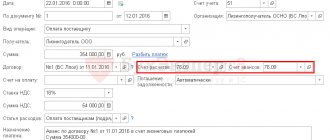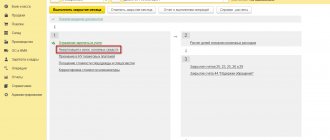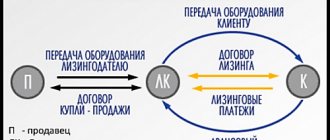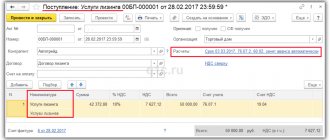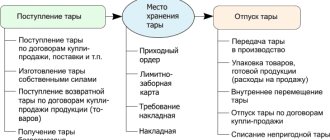Tax and accounting, postings
Tax accounting of equipment leased is regulated by Letter No. 03-11-04/2/71 of the Ministry of Finance of the Russian Federation dated September 7, 2005, as well as by Law 164-FZ and the Civil Code of the Russian Federation.
Article navigation
- Tax accounting of fixed assets in leasing
- Taxation VAT
- Taxation of profits
- Tax accounting for the lessee and the lessor
- Initial cost of the leased asset in tax accounting
- Tax differences
- Tax accounting of penalties under a leasing agreement
- Tax refund on leasing
- Specifics of taxation of financial and operational leasing
- Tax accounting with the lessor
Financial leasing is beneficial for enterprises not only because it allows you to purchase means of production quickly and with minimal initial investment. Leasing is used to optimize taxation. This article is about how to take full advantage of these benefits.
On the transfer of movable property into leaseback and subsequent taxation and benefits
Situation: Is the property tax exemption covered when transferring movable property into leaseback after 01/01/2013, while the property is listed on the balance sheet of the lessee-former owner (seller of this property)?
Answer: This property is not subject to tax, subject to the following conditions: the lessee and the lessor are not interdependent persons (not from the list of persons mentioned in paragraph 2 of Article 105 of the Tax Code of the Russian Federation). If this condition is not met, tax must be paid.
Important point: When leasing back, movable property, which from 01/01/2013. is included in the operating system of the enterprise, is not subject to property tax, and it does not matter whether the property was owned by the lessee in the past.
Tax accounting of fixed assets in leasing
The first obvious tax advantage of leasing for the tenant is that he does not pay property taxes. In most cases, the item remains on the balance sheet of the lessor.
The relations of the parties to a financial lease agreement are regulated by Federal Law 164-FZ and the Civil Code of the Russian Federation. According to these legal documents, rental objects can be non-consumable items that do not lose their natural properties during operation, with the exception of natural resources.
Fixed assets in leasing remain the property of the lessor at least until the end of the contract. Upon completion, the item can be purchased (or not) by the lessee at a residual value of no more than a quarter of the initial price.
Tax accounting of equipment leased is regulated by Letter No. 03-11-04/2/71 of the Ministry of Finance of the Russian Federation dated September 7, 2005, as well as the above-mentioned legislative acts. Fiscal obligations are assigned to one of the parties between whom the leasing agreement is concluded. In tax accounting, equipment transferred under financial lease is placed on the balance sheet as a fixed asset. In addition, the associated costs of delivery, installation and other costs accompanying the process of transferring the item are taken into account. They are borne by the lessor (LD) or he compensates them to the lessee (LP), including them in the total amount of the initial cost of the equipment.
Taxation VAT
The procedure for calculating VAT is the same for ordinary and financial leases. Based on Articles 171 and 172 of the Tax Code of the Russian Federation, several conditions are put forward for granting the right to deduct:
- The property is transferred to the lessee (tenant), who is a VAT payer.
- The leasing service was actually provided during the tax period.
- The service is reflected by the lessee in its accounting.
The lessor provided an invoice for the amount of the lease payment (rent) in accordance with Article 169 of the Tax Code of the Russian Federation.
Taxation of profits
The balance holder is determined by agreement of the parties to the agreement - it can be the lessor (owner) or the lessee. The procedure for taxing profits depends on who takes the item into account.
If the balance holder is LD, then the full amount of the accrued payment is taken into account by him as part of expenses. LP makes similar accruals, but the leasing payment is divided into the number of periods for repaying obligations (monthly) according to the selected payment scheme (annuity, progressive, regressive).
The lessee includes the amount of the monthly payment among other production and sales expenses.
Tax accounting of leased property on the balance sheet of a private enterprise is somewhat more complicated. The lessee determines the appropriate depreciation group. The book value corresponds to the LD's costs of acquiring the item and bringing it to a state of operational suitability. The lessor depreciates the property using the method he chooses, including these amounts as expenses. In this case, it is allowed to use an accelerating factor of no more than 3, with the exception of items belonging to the first three groups (it is advisable to include this condition in the text of the contract).
LP also includes in its expenses the lease payment for a given tax period minus accrued depreciation.
Payers of the unified agricultural tax (UAT) and business entities using the simplified tax system also have the right to include leasing and VAT payments in their expenses after paying these amounts.
Are there any advantages to leasing over renting?
In the table we will look at the advantages of leasing over renting for an organization / individual entrepreneur.
| Comparison criteria | Lease contract | Leasing agreement (without right of purchase) |
| Economic essence of the agreement | Identically aimed at renting property for a certain fee | |
| Opportunity to take advantage of tax advantages | No | Eat |
| Monthly payment amount | Fixed | May be uneven Comment: both parties to the transaction can change the amount of leasing payments and transfer the tax burden for VAT and income tax in accordance with paragraph 1 of Article 146 and Article 171 of the Tax Code of the Russian Federation, from the lessee to the lessor and vice versa. |
| Opinion of representatives of the Federal Tax Service regarding the payment schedule | Unpretentious | Claims are being made by regulatory authorities, who justify them with paragraph 1 of Article 272 of the Tax Code of the Russian Federation, which states that expenses should be distributed over several periods in advance if the agreement provides for the receipt of leasing payments for more than one period (month). However, the possibility of uneven payments is supported by letters of the Ministry of Finance of the Russian Federation No. 03-03-05/131 dated October 15, 2008. and Federal Tax Service of the Russian Federation No. 3-2-13/179 dated August 19, 2009. The courts adhere to a similar opinion, for example, resolution of the Federal Antimonopoly Service of the Ural District No. F09-11634/12 dated December 7, 2012. and FAS Volga District No. A55-17520/2008 dated June 25, 2009. |
Tax accounting for the lessee and the lessor
Typical entries in the lessee's NU are summarized in two tables. If the leased item is on the balance sheet of the lessee, then they will look like this:
| Account correspondence | Operation description | |
| Dt | CT | |
| 20 | 76-2 (sub-account “Arrears of rent payments”) | Calculation of lease payment |
| 19 | 76-2 | VAT accounting |
| 76-2 (sub-account “Arrears of rent payments”) | 51 | Transfer of money to the lessor |
| 68 | 19 | Accounting for taxes on leasing – submission of input VAT for deduction |
The table shows that the taxation of leasing costs provides for their inclusion in the costs of paying arrears of lease payments.
If the balance holder is the lessor:
| Account correspondence | Operation description | |
| Dt | CT | |
| 08 | 76-1 subaccount “Rental obligations” | Reflection of the cost of the leased object as a capital investment |
| 19 | 76-1 | Accounting for VAT on the amount of leasing payments |
| 01 | 08 | Reflection of the lessee crediting the item to the balance sheet as a fixed asset |
| 76-1 subaccount “Rental obligations” | 76-2 | Calculation of monthly lease payment |
| 76-2 | 51 | Transfer of payment amount to the lessor |
| 68 | 19 | “Input” VAT is presented for deduction |
Initial cost of the leased asset in tax accounting
In the ideal case of a finance lease, the initial cost is equal to the estimated amount of all lease payments. In real life, situations may arise that complicate the tax accounting process.
Article 257 (clause 1) of the Tax Code of the Russian Federation directly states that the initial cost includes all the lessor’s expenses incurred in the process of bringing the facility to operational readiness. Cost items may include, in addition to the purchase price from the seller, delivery, installation, setup, etc.
In the process of use, an item is sometimes completed, reconstructed, modernized, technically re-equipped, or partially liquidated. All these processes entail additional costs and affect the amount of leasing payments. Its original cost remains unchanged.
If the financial lease agreement is valid for more than a year (tax period), taxation is distributed in equal shares by month. This recommendation is contained in the Letter of the Ministry of Finance of the Russian Federation No. 03-03-06/1/645 dated November 21, 2008.
If the contract provides for the redemption of an item after its expiration, then the redemption value can be distributed between leasing payments. This significantly reduces the income tax burden, increasing the company's depreciation expenses.
Under the terms of the financial lease agreement, LD may increase the amount of lease payments. He has the right to do this if he carries out completion, additional equipment, reconstruction, modernization, etc.
If an item is taken into account on its balance sheet, it also charges depreciation on it.
If an already operating facility is transferred to a financial lease, the basis for determining its initial value is the residual value (less depreciation already incurred) plus all additional costs to make it operational.
Simplified taxation regime with the taxable object “Income minus expenses” (hereinafter referred to as the simplified tax system 15%)
Accounting for transactions under a leasing agreement
Basically, the accounting of leasing transactions for organizations that use the 15% simplified tax system (which may relate to small businesses) does not differ from the general standards of display in the accounting of the lessee organization - the balance holder of the leased property, with the exception of the following features:
- in the accounting of a lessee using the simplified tax system 15% regime, transactions will not be reflected taking into account the amounts of deferred income tax - account 77 “Deferred tax liability”;
- the amount of VAT charged by the lessor can be taken into account in the price of the leased property on the basis of PBU 6/01 (approved by Order of the Ministry of Finance of the Russian Federation No. 26n dated March 30, 2001), according to which the actual expenses for the purchase, construction and production of fixed assets included in their primary cost includes, in particular, non-refundable taxes that are paid in connection with the purchase of fixed assets.
| Transfer by the lessee of the advance payment established in the leasing payment schedule | |
| D 76-leasing/advance – K 51 | Advance payment transferred |
| Registration of the leased asset | |
| D 08 – K 76-leasing/rental obligations | Received property from the lessor |
| D 01-leasing – K 08 | Leased property is included in the fixed assets |
| Leasing payments | |
| D 76-leasing/rental obligations – K 76-leasing/current payments | Lease payment accrued |
| D 76-leasing/rental obligations – K 76-leasing/advance | Offsetting the advance payment under the leasing agreement to repay the obligation under the leasing agreement |
| Accounting for expenses on leased property | |
| D 20 (26, 44) – K 02-leasing | Depreciation accrued on leased property |
| D 02-leasing – K 01-leasing | At the end of the contract, the cost of the fully depreciated leased property is written off |
| Redemption of leased property by the lessee | |
| D 10 (or 08) – K 60 | Acquisition of leased property (the subject of lease) at a price including VAT |
Value added tax (VAT)
In the situation under consideration, the lessee-balance holder applies the 15% simplified tax system, which implies his exemption from VAT, at the same time, the amount of incoming VAT is subject to reflection in the expenditure side when the tax base for the 15% simplified tax system is calculated in accordance with subparagraph. 8 clause 1 art. 346.16 of the Tax Code of the Russian Federation (Letter of the Ministry of Finance No. 03-11-11/48495 dated 08/21/2015).
Paying tax when using the simplified tax system
Leasing payments, deducted monthly, and VAT, which was presented by the lessor, are recorded as expenses for the lessee as they are paid on the basis of clause. 4, 8 p. 1 art. 346.16, paragraph 2 of Art. 346.17 Tax Code of the Russian Federation.
When the redemption price is paid and ownership rights to the fixed asset are transferred to the organization, the indicated price refers to the costs associated with the purchase of the fixed asset, which constitute equal shares in each reporting (tax) period throughout the tax period (Tax Code of the Russian Federation - subparagraph 1 p. 1, subparagraph 1, paragraph 3, paragraph 8, paragraph 3, Article 346.16, subparagraph 4, paragraph 2, Article 346.17; see also Letter of the Ministry of Finance of the Russian Federation No. 03-03-02-04/1/88 (according to issue 3), Letter of the Ministry of Finance No. 03-11-06/2/56616 dated 10/02/2015).
The current tax legislation (Tax Code of the Russian Federation - subparagraph 3, paragraph 2, article 170) provides for the possibility of an alternative method of accounting for the lessee's incoming (presented by the lessor) VAT through its inclusion in the cost of the acquired assets, i.e., by receiving ownership of the leased property, the lessee can take it into account within the framework of tax accounting under the simplified tax system (USNO) of 15% at a price including VAT. Thus, taking into account that the norms of Chapter 25 of the Tax Code of the Russian Federation “Income Tax” regulate the accounting of depreciable property, which is applied in Chapter 26.2 of the Tax Code of the Russian Federation “Simplified Taxation System”, the above norm of Art. 170 of the Tax Code of the Russian Federation is valid if its application is approved by the taxpayer in its accounting policy.
Tax differences
The difference in accounting and tax accounting for leasing lies in the different approach to the concept of expenses. In accounting, these are understood as regular payments under a finance lease, and NU is the amount of accrued depreciation. With a nonlinear (progressive or regressive) system of calculations between LD and LP, these values may not coincide - in practice this most often happens. Ultimately, at the end of the contract, they are equalized, but temporary differences between tax and accounting arise. They entail uneven fiscal obligations. The amounts of taxes according to accounting and NU do not match.
In particular, this situation arises already in the initial period of operation of leasing equipment, when the rental payment has already been made, and the accountant begins to calculate depreciation only from the next month after the facility is put into operation.
Experts recommend reducing the amount of temporary difference by subtracting depreciation from the lease payment when calculating income tax if the property is on the balance sheet of the company. In this case, the accountant may refer to subparagraph 10 of paragraph 1 of Article 264 of the Tax Code of the Russian Federation.
Tax accounting of penalties under a leasing agreement
If one of the parties violates the terms of the leasing agreement, the counterparty has the right to impose financial sanctions. They can be spelled out in a special way in the text of the agreement, but in practice and by default they are accepted as one three hundredth of the discount rate of the Central Bank of the Russian Federation, accrued on the amount of debt for each overdue day. If the penalty, fine or penalty required by the creditor is beyond reasonable limits, the sanctions can be challenged in court.
In the tax accounting of the recipient of the penalty, it is taken into account in “other income.” Accordingly, like any other additional profit, it is taxed, regardless of what system the enterprise has adopted (STS, OSN).
Postings for penalties are reflected in the correspondence of accounts:
- Dt76 – Kt91.1 – accrual of a fine (forfeit, penalty);
- Dt51 – Kt76 – crediting funds to a bank account.
The payer of the penalty classifies it as other expenses:
- Dt91.2 – Kt76 – charging a fine;
- Dt76 – Kt51 – transfer of the amount of penalties from a bank account.
In this case, the profit tax base is reduced by the amount of the sanction, since in fact it represents losses.
Simplified taxation regime with the taxable object “Income” (hereinafter referred to as the simplified tax system 6%)
Accounting for transactions under a leasing agreement
Basically, the accounting of leasing transactions for organizations that use the simplified tax system (which may relate to small businesses) does not differ from the general procedure for recording in the accounting of the organization that is the recipient of the lease and the balance holder of the leased property, excluding the following conditions:
- in the accounting of a lessee using the 6% simplified tax system regime, transactions that take into account amounts of deferred income tax - account 77 “Deferred tax liability” will not be reflected;
- the amount of VAT presented by the lessor can be taken into account in the price of the leased property on the basis of PBU 6/01 (approved by Order of the Ministry of Finance of the Russian Federation No. 26n dated March 30, 2001), according to which the actual expenses for the acquisition, construction and production of fixed assets included in their primary cost includes, for example, non-refundable taxes that are paid in connection with the purchase of fixed assets.
| Transfer by the lessee of the advance payment established in the leasing payment schedule | |
| D 76-leasing/advance – K 51 | Advance payment transferred |
| Registration of the leased asset | |
| D 08 – K 76-leasing/rental obligations | Received property from the lessor |
| D 01-leasing – K 08 | Leased property is included in the fixed assets |
| Leasing payments | |
| D 76-leasing/rental obligations – K 76-leasing/current payments | Lease payment accrued |
| D 76-leasing/rental obligations – K 76-leasing/advance | Offsetting the advance payment under the leasing agreement to repay the obligation under the leasing agreement |
| Accounting for expenses on leased property | |
| D 20 (26, 44) – K 02-leasing | Depreciation accrued on leased property |
| D 02-leasing – K 01-leasing | At the end of the contract, the cost of the fully depreciated leased property is written off |
| Redemption of leased property by the lessee | |
| D 10 (or 08) – K 60 | Acquisition of leased property (the subject of lease) at a price including VAT |
Value added tax (VAT)
In our case, the lessee-balance holder uses the 6% simplified tax system, and therefore he is exempt from paying VAT, as well as from accounting for expenses for calculating the 6% simplified tax system, taking into account the circumstances of the formation of the tax base only from the profit received by the taxpayer.
Tax refund on leasing
Tax savings for the lessee arise automatically if he is not the balance holder. In addition, all of his costs for acquiring the property in the form of rent payments are considered direct expenses and reduce the profit tax base. But that is not all. You can reduce leasing taxes by receiving a VAT refund.
Article 258 of the Tax Code of the Russian Federation indicates the right to carry out depreciation of the balance holder of an item, including accelerated depreciation. In this case, the cost of the fixed asset is determined as the total lease payment excluding VAT. Thus, the right to a budgetary reimbursement (deduction) of this tax is indicated. This is possible if several conditions are met:
- Operation of the facility by a VAT payer.
- Availability of correctly completed receipt documentation for financial lease.
- Registration of the leased object for accounting.
- Confirmation of payment for property by the lessee, including transfer and acceptance certificates, agreement, etc.
Theoretically, problems with compensation should not arise, but in real life they sometimes occur. The most common reasons for refusal are:
- non-cash payment (mainly in cases with cars);
- ambiguous confirmation of payment or the very fact of leasing relations;
- bankruptcy of the lessee organization;
- the company's attraction of large financial borrowings.
- lack of monthly acts confirming the provision of financial lease services (for real estate).
Of course, complete tax evasion through leasing is impossible, but a significant reduction in the fiscal burden is possible.
About property tax when purchasing a leased car
Situation: Is the property tax exemption applicable when purchasing a leased car and is there a need to file a declaration?
Answer: Regardless of whether the organization is exempt from property tax or individual property of the organization is exempt from this tax, the use of tax benefits imposes an obligation on the company in the form of filing a tax return (advance calculation).
According to Article 381 of the Tax Code of the Russian Federation, which lists tax benefits, movable property belonging to depreciation groups III to X (in accordance with the Classification of fixed assets), which were registered on January 1, 2013, is exempt from property tax. However, there is an exception: if movable property was received as a result of the reorganization (or liquidation) of an organization, then it does not qualify for the benefit (according to paragraph 25 of Article 381 of the Tax Code of the Russian Federation and letters of the Ministry of Finance No. 03-05-05-01/30592 and No. 03-05 -05-01/14933 dated April 27, 2021 and March 17, 2021, respectively). Consequently, a vehicle that was purchased during the leasing process is eligible for property tax relief.
Comment: Payers of property tax are organizations whose balance sheets include property that is indicated, in accordance with Article 374 of the Tax Code of the Russian Federation and paragraph 1 of Article 373 of the Tax Code of the Russian Federation, as an object of taxation. Consequently, the absence of this property on the organization’s balance sheet exempts this organization from paying tax and submitting a tax return and making advance payments.
Specifics of taxation of financial and operational leasing
Tax accounting of financial leasing is regulated by Article 78 of the Tax Code of the Russian Federation. It differs from the operational form in that during the term of the contract the accrued amount of depreciation must be at least three-quarters of the cost of the item.
The tax treatment of ordinary finance leases is described above. In the operational form of leasing, the accrual of fiscal obligations is somewhat different. Profit is calculated monthly, based on the payment amount, rental period, price of the item, depreciation and its initial cost. VAT is also charged on each rental payment according to the current rate.
The amount of depreciation during operational leasing is always less than the lease payment - otherwise LD will incur losses.
Answer
In this case, what should the lessor do to collect the penalty under the contract? Should I go to court every time payment terms are missed? Or, at the end of the contract, issue the lessee with a penalty amount? Is it possible to file a claim only for the amount of the penalty?
The use of an increasing coefficient is a right, not an obligation of the taxpayer. Moreover, he can apply a special coefficient in an amount less than 3.
In this case, the lessor, if the requirement to pay the penalty voluntarily is not satisfied, at his own discretion has the right to go to court with a claim to collect only the penalty, both before the end of the contract for the period from the moment of delay until the decision is made, and at the end of the contract. In this case, it is necessary to ensure that the statute of limitations has not expired by the time the claim is filed.
This is exactly how I introduce acts. Interested in how to draw up this document?! After all, you can’t just post it to expense account 26, like leasing itself. Which account should I use to post this document? HE03 or 91.02, or another?
The amount of the penalty is proven based on the terms of the contract. Since the penalty is collected for late periodic payments, it should first be calculated based on the amount of the first overdue payment, then when the next payment is due, the amount for calculating the penalty is increased by the amount of the next payment. Responsibility for the safety of the leased asset from all types of property damage, as well as for the risks associated with its destruction, loss, damage, theft, premature breakdown, error made during its installation or operation, and other property risks from the moment of actual acceptance of the leased asset is borne by the lessee, unless otherwise provided by the leasing agreement (Clause 1, Article 22 of Law No. 164-FZ). Leasing transactions can be an excellent solution for companies that are forced to pay VAT due to the nature of their activities. In this case, 18% of the amount specified in the contract can be returned or credited. When concluding large transactions, this can significantly reduce the tax burden of the lessee. The main document on the basis of which an accounting statement is drawn up to reflect leasing obligations (as, in fact, the document that reflects the payment procedure) is the payment schedule. Amounts of leasing remuneration must be accrued in accounting during periods and terms in accordance with the payment schedule, which is an integral part of the leasing agreement.
However, in some cases this is considered as a redistribution of the tax burden, since for certain categories of lessees payments are significantly increased compared to those during the period of the financial lease agreement.
Please note: the amount of leasing payments is determined by the leasing agreement, regardless of the fact of payment. Including in cases where these payments are transferred quarterly, monthly or in another manner.
When using the accrual method, the date of recognition of expenses in the form of penalties and interest for late payment is determined as the date of recognition of the debt or the entry into force of a court decision to collect the debt* (subclause 8, paragraph 7, article 272 of the Tax Code of the Russian Federation, letters of the Federal Tax Service of Russia dated June 26, 2009 No. 3-2-09/121, Ministry of Finance of Russia dated December 23, 2004 No. 03–03–01–04/1/189). The debtor's recognition of the debt can be confirmed by any documents indicating that the debtor agrees to pay a penalty (interest on late payment). For example, a letter from the debtor or an act of reconciliation of debts between organizations (letters of the Ministry of Finance of Russia dated December 23, 2004 No. 03-03-01-04/1/189, Federal Tax Service of Russia dated June 26, 2009 No. 3-2-09/121) . In accordance with the Information Letter of the Presidium of the Supreme Arbitration Court of the Russian Federation dated October 20, 2010 No. 141, when funds are received from the lessee to the lessor’s current account, penalties for late fulfillment of the obligation to pay lease payments must be paid off last. In this case, what should the lessor do to collect the penalty under the contract? Should I go to court every time payment terms are missed? Or, at the end of the contract, issue the lessee with a penalty amount? Is it possible to file a claim only for the amount of the penalty? And how, in this case, can one prove the amount of the penalty if the payment is periodic?
Penalties are charged to account 76.2 with subsequent closure to account 91.2 (Instructions for using the Chart of Accounts; clauses 11 and 14.2 of PBU 10/99). Include penalties for delay as expenses on the date of their recognition or on the day the court decision enters into legal force* (clause 14.2 of PBU 10/99). The debtor's recognition of the debt can be confirmed by any documents indicating that the debtor agrees to pay a penalty (interest on late payment).
Let's look at a specific example of how the amount of property tax payment will change when leasing. Let’s assume that company A has entered into a financial lease agreement, the amount of which is 2,000,000 rubles including VAT. Let this be the 5th depreciation group, and the depreciation period will be equal to 60 months, the coefficient allowed for use will be equal to 3. Therefore, instead of 60 months, 21 months will be spent on depreciation (60/3 + 1). Accounting for expenses of the lessee for profit tax purposes differs significantly from the rules established by accounting legislation.
Postings when buying or returning a car
As noted above, all accounting for leasing transactions, including repurchase/return of the car, depends on what conditions are specified in the contract. The drug we are considering will be characterized by the following common nuances:
- If the car is included in the balance sheet of the LP, then upon completion of the redemption payments from the LP, it must be transferred from the category of leased objects to the category of own objects:
| Posting Contents | Dt | CT | Note |
| The purchased car is transferred to own fixed assets | 01/ Fixed assets | 01/ Property under lease | In the amount in which it was capitalized upon receipt |
| We do the same with depreciation that we managed to accrue during the term of the contract. | 02/ Depreciation of leased property | 02/ Depreciation | In the amount that has accumulated on 02 for leasing at the time of redemption |
NOTE! After transferring the purchased car to your own fixed assets, you can deduct VAT on advances towards the redemption.
- If the car was taken into account on the LD balance sheet before the redemption, then the LP performs the following operations upon redemption:
| Posting Contents | Dt | CT | Note |
| The purchased car is removed from off-balance sheet accounting | 001/ Property under lease | In the amount in which it was capitalized upon receipt under the leasing agreement | |
| The purchased car is accepted for balance | 08 | 76 | At 76 there can be 2 accounting options:
|
Next, the LP keeps records of the purchased car as an ordinary fixed asset received, for example, during the purchase and sale. VAT on the purchase price is deducted in the standard manner.
The deduction of VAT from expenses incurred by the lessee when receiving property (for example, transportation), as well as from lease payments and the redemption value of leased property, is described in detail in the Ready-made solution from ConsultantPlus. Get trial demo access to the K+ system and study the material for free.
- Sometimes a situation arises when the car must be returned to the LD at the end of the contract. For the LP accounting department, this simplifies the accounting task, since usually if a car is subject to return, it does not go onto the LP balance sheet. Accounting for the disposal of such a car in this case will be similar to accounting for a regular lease. Upon completion of leasing payments and upon return of the car, it must be removed from off-balance sheet account 001. Payment of the redemption price will not be reflected in the LP, and the posting of the car to the balance sheet will not be reflected either.
All details related to the reflection by the lessee in accounting for transactions under a leasing agreement, if he applies FAS 25/2018, are given in the Ready-made solution from ConsultantPlus. Study the material by getting trial access to the K+ system for free.
Penalties under the leasing agreement - postings
A leasing agreement is a type of rental agreement, according to which the lessor purchases equipment from the seller and provides it for temporary use to the lessee for a specified fee.
Often, for late payments in accordance with the leasing agreement, a penalty is provided in the form of a penalty. According to Art. 330 of the Civil Code of the Russian Federation, a penalty is an amount of money fixed at the legislative or contractual level that must be paid by the debtor to the creditor in the event of non-fulfillment or improper fulfillment of obligations, including in case of delay in the next payment.
In accordance with current legislation, the lessor is not obliged to confirm the fact of the loss, nor to specify the amount. This is due to the fact that the concept of a penalty means the accrual of a certain percentage of the amount of the overdue payment under the agreement.
It should be borne in mind that the amount of penalties is determined individually in each specific case. But in most situations, the formula for their calculation is the same, regardless of the type of violated obligation of the lessee: the amount of penalties is equal to 1/300 of the refinancing rate of the Central Bank of the Russian Federation of the amount of debt for each overdue day.
- If the amount of the penalty fixed by the agreement is too high, then this amount can be reduced in court.
- If neither the agreement nor the law stipulate sanctions for the defaulter, then penalties are collected for the use of third-party funds as a result of their illegal retention.
- In an enterprise that receives fines for violating the terms of a leasing agreement, they are reflected in accounting as other income.
The fine is charged by posting: Dt 76 Kt 91.1.
In an organization that pays fines for violated contract terms, these costs are reflected in accounting as other expenses.
The fine is charged by posting: Dt 91.2 Kt 76.
Payment of the fine from a bank account is reflected as follows: Dt 76 Kt 51.
In tax accounting, according to the Tax Code of the Russian Federation, fines are recognized as non-operating expenses, which reduce taxable profit. This applies to enterprises subject to the general taxation system. For organizations using the simplified tax system, the object of taxation is the result of subtracting expenses from income.
The accounting reflection of entries for tax penalties is carried out depending on the period and types:
- penalties after closing the annual report are taken into account on 91 accounts;
- penalties for compensated types of taxes are recorded in 91 accounts;
- penalties for uncompensated taxes are reflected in account 99.
The financial activity of an enterprise is, first of all, the desire to make a profit. However, anticipating high incomes, every manager must remember his obligations, especially to the state. An attempt to save money through taxes will lead to liability of the legal entity, expressed in the form of sanctions.
Of course, besides tax evasion, there are other reasons that can lead to sanctions from the fiscal authorities:
- violation of the rules for managing income and expenses;
- late submission of reports;
- delay in payment;
- incorrectly calculated tax amount.
Each of the listed offenses is a reason for imposing fines. As for penalties, then, according to Art. 75 of the Tax Code of the Russian Federation, they can be issued exclusively for late payment of a tax or fee.
If the fine is an amount fixed by law, then the penalty usually causes accountants difficulties in calculating. The tax authority, of course, itself calculates how much the company owes, but many legal entities prefer to check the accuracy, since errors occur.
note
Clause 4 art. 75 of the Tax Code of the Russian Federation directly states that the penalty is charged as a percentage of the amount of arrears in the amount of 1/300 of the refinancing rate for each calendar day, starting from the day of delay.
For debts of legal entities, the payment period for which came after September 30, 2017, a different scheme applies:
- late payment up to 30 days - 1/300 of the refinancing rate;
- over 30 days of delay - 1/150 of the refinancing rate.
Note from the author! The refinancing rate is the percentage of loans granted to other banks approved by the Central Bank.
Tax arrears * calendar days of delay * 1/300 (1/150) of the refinancing rate.
Sanctions are assessed the next day after the payment deadline.
For example, Tsvetnoy Mir LLC paid VAT in the amount of 20,365 rubles for July on October 13. According to paragraph 1 of Art. 174 of the Tax Code of the Russian Federation, VAT must be paid no later than the 25th day of the month following the reporting month. Therefore, this had to be done before August 25, 2021.
After checking the calendar, the accountant calculated the number of days of delay - 48, starting from August 26. Since this debt was formed before September 30, 2021, the refinancing rate will be calculated in one way and will remain 1/300, regardless of the number of days.
A penalty is an amount of money that must be paid in excess of the amount of overdue taxes (Clause 1, Article 75 of the Tax Code of the Russian Federation). But it happens that the payment of penalties is also provided for in business contracts (for example, a purchase and sale agreement).
We will tell you in our consultation what kind of entries are formed in accounting when calculating penalties.
In accordance with the Chart of Accounts (Order of the Ministry of Finance dated October 31, 2000 No. 94n), the amounts of tax penalties due are reflected in the debit of account 99 “Profits and losses” in correspondence with the account for accounting settlements with the budget for taxes.
Debit account 99 – Credit account 68 “Calculations for taxes and fees”
Moreover, since analytical accounting for account 68 is carried out by type of tax, the credit of this account indicates the type of tax for which penalties were accrued.
Debit account 99 – Credit account 68, sub-account “VAT”
Debit account 68, sub-account “VAT” - Credit account 51, etc.
Debit of account 99 – Credit of account 68, subaccount “USN”
When calculating penalties on contributions, accounting entries will also consist of a debit to account 99, but for a loan you need to indicate account 69 “Calculations for social insurance and security”
Penalties under contracts
When calculating penalties in accounting, the entries may be different if we are not talking about a violation of tax laws, but about non-fulfillment of the terms of business agreements concluded between counterparties.
After all, sanctions for violation of the terms of the contract (fine, penalty, penalty, etc.) are other income or expenses, depending on whether these amounts are due for accrual or payment (clause 7 of PBU 9/99, clause 11 of PBU 10 /99). Therefore, in the entries for calculating penalties for late payments under the contract, it will not be account 99, but account 91 “Other income and expenses” (Order of the Ministry of Finance dated October 31, 2000 No. 94n).
Debit of account 91 “Other income and expenses”, sub-account “Other expenses” - Credit of account 76 “Settlements with various debtors and creditors”, sub-account “Settlements on claims”
Debit of account 76 – Credit of account 91, subaccount “Other income”
Penalty or, more commonly, interest is money that is collected as a fine from the payer for late payment within the deadlines established by law. They may be charged taxes and insurance premiums.
They are calculated for each day that elapses from the date when the payment was due until the day the debt is repaid. Calculated based on the refinancing rate.
In this article we will look at the nuances of their accounting and the main entries for the calculation and payment of penalties for taxes.
The penalty is a percentage ratio of 1/300 to the refinancing rate of the Central Bank of the Russian Federation. The payer transfers the amount of penalties voluntarily or compulsorily (without the payer’s consent, the money is written off from his current account), simultaneously or after paying off debts on taxes or insurance fees.
More on the topic CASCO calculator online for all insurance companies
According to PBU 10/99, they are recognized as other expenses in accounting and are reflected in the debit of account 99 “Profits and losses” and the credit of accounts 68 and 69. These expenses cannot be recognized in tax accounting.
In other words, these penalties do not reduce the firm's taxable income.
The opinion that the amounts of the listed penalties should be reflected in the debit of account 91 “Other expenses” and credit 68 and 69 has become widespread in accounting practice. If you take into account penalties specifically for this account, a permanent tax liability (PNO) arises, which complicates accounting.
The main argument for reflecting penalties on 91 accounts is the definition of sanctions in the Tax Code, which includes the concept of “fine”. And on account 99 you can reflect tax sanctions. In income tax reporting, such amounts are combined into one category.
Another “pro” in favor of accounting for penalties on account 99 is the reliability of reporting. If the amount falls on 91, the taxable profit base is underestimated, since other expenses are taken into account in expenses.
At the same time, the amounts of sanctions on account 99 do not form expenses. This does not contradict the main objective of accounting - the presentation of unconditional and genuine information about the financial performance of the organization.
As mentioned above, penalties should not reduce income taxes. Therefore, it is better to use posting D99 “Tax sanctions” K 68.4 “Income tax”. If the organization decides to account for them on account 91, the posting will look like: D91 “Other expenses” K 68.4.
→ Accounting consultations → Accounting
Current as of: December 18, 2021
Leasing is a popular form of financing capital investments. After all, without incurring significant one-time costs compared to the value of the property, the lessee, having concluded a leasing agreement with the lessor and paying lease payments, will receive the necessary property for temporary possession and use (Article 2 of Federal Law No. 164-FZ of October 29, 1998).
We will show you with examples in our consultation how to keep accounting records for the lessee if the object is accounted for on the balance sheet of one or the other party to the agreement.
The legislative framework
The most popular tool for protecting the interests of lessors is a penalty. The interests of the leasing organization in the event of failure by the lessee to comply with the terms of the lease are protected by a number of legislative acts:
- Sections of Part I of the Civil Code of the Russian Federation (Chapter 2 on the exercise and protection of citizens’ rights, including Article 15 on compensation for losses; Chapters 22, 23, 25 on issues of fulfillment of obligations and liability for non-fulfillment; Chapter 29 on amendment and termination of an agreement ).
- Separate parts of Chapter 34, Part II of the Civil Code of the Russian Federation on the general provisions of rent and leasing.
- Law “On financial lease (leasing)” dated October 29, 1998 No. 164-FZ.
- Order of the Ministry of Finance of the Russian Federation on accounting for leasing operations dated February 17, 1997 No. 15.
- PBU 6/01 on accounting for fixed assets.
Is leasing subject to VAT?
In general, yes, because within the meaning of sub.
1 clause 1 art. 146 of the Tax Code of the Russian Federation, leasing can rightfully be considered a special case of the sale of goods. The fact that the property acquired by a company on lease does not immediately become its property (and sometimes does not become its property at all) does not matter. Almost always, the VAT rate when leasing a car, building, or aircraft is 20% (Law “On Amendments to Certain Legislative Acts of the Russian Federation on Taxes and Fees” dated August 3, 2018 No. 303-FZ). Exceptions include, for example, leasing of breeding livestock and poultry - until the end of 2020, a VAT rate of 10% applies.
In some cases, leasing transactions are exempt from VAT.
Accounting for a leasing agreement with the lessee
If the balance holder of the leased asset is the lessee, then the following algorithm of actions is provided.
- Receiving the leased item
The value of received property is reflected in the following entry:Dt 08 “Purchase of individual fixed assets under a leasing agreement” kt 76 “Lease obligations”.
Account 08 is used to reflect transactions related to investments in non-current assets of the company.
Top 3 articles that will be useful to every manager:
- How to pay insurance premiums
- How to fire a chief accountant: nuances of the procedure
How to minimize taxes and not interest the tax authorities
Account 76 is intended to reflect transactions for settlements with debtors and creditors.
Next, you need to write off the costs incurred by the lessee when purchasing the leased property, and the cost of this property using the posting dt 01kt 08.
Account 01 – OS. The subaccount used is leased property.
Regulatory document – second paragraph of clause 8 of the Guidelines.
If the balance holder is the lessee, then the leased asset is included in the fixed assets at its original cost, defined as the total amount of the lessee's debt to the lessor, based on the terms of the leasing agreement, but excluding VAT. This point is regulated by clauses 4, 7, 8 of PBU 6/01 and the second paragraph of clause 8 of the Directives.
According to the Resolution of the FAS NWZ dated November 19, 2010 on proceedings No. A26-11541/2009 (the Supreme Court of the Russian Federation in Determination No. VAS-251/11 dated April 12, 2011 refused to review case No. A26-11541/2009), the lessee’s expenses, incurred as a result of transporting the leased property and bringing it into a state of operational readiness (design work, installation and commissioning) cannot be included in the initial cost of this property if, under the terms of the lease agreement, the balance holder is the lessee.
Accrual of payments to the lessor:
Dt 76 “Lease obligations” Kt 76 “Debt on leasing payments”
Regulatory document – second paragraph of clause 9 of the Guidelines. In other words, in this case, the amount of payments due to the lessee is not an expense for the lessee.
Property on the lessor's balance sheet
When concluding a leasing agreement, the parties must decide who will have the property on their balance sheet. Two options are allowed: the object is transferred to the lessee or remains registered with the lessor. In any case, existing leasing reduces income tax. But a number of nuances should be taken into account.
If the property remains on the lessor's balance sheet, the process of recognizing expenses when calculating income tax is almost the same as when concluding a lease agreement. Cost accounting is carried out depending on the accrual method adopted in the organization:
- Under the cash method, lease payments are accepted as expenses as they are actually paid.
- If the accrual method is used, payments are counted as expenses on a monthly basis, regardless of whether the funds were transferred to the recipient or not. Amounts must be in accordance with the current payment schedule.
Example. An organization using the accrual method of accounting purchased a car on lease for a period of 3 years. The monthly payment is 28,800 rubles, including 20% VAT - 4,800 rubles. The object remained on the balance sheet of the lessor. Every month, during the term of the agreement, the lessee makes the following entries in the balance sheet:
- Dt 20 (25, 26, 41) Kt 60 (76) – 28,550 rubles – the accrued lease payment is reflected in expenses.
- Dt 19 – Kt 60 (76) – 4,800 rubles – accepted for VAT deduction.
The tax base is also reduced by penalties accrued by the lessor for late payment. In accounting, they are formed on the date of their recognition by the guilty person or after actual payment. Classified as other expenses:
- Dt 76 – Kt 91.2 – penalties under the leasing agreement are recognized by the lessee;
- Dt 91.2 – Kt 51 – payment of penalties.
The last or redemption payment in the lease payment schedule
The buyout or final lease payment varies from company to company from 1 to 20%. If it is less than 100,000 rubles, then it refers to material costs, if more, it refers to the cost of acquiring fixed assets. This is of great importance for correct accounting.
The algorithm for reflecting the redemption payment depends on whose balance sheet the leased asset was on.
| Lessor's balance | ||
| Debit | Credit | Wiring Description |
| 001 | The property has been written off | |
| 08 | 60 | If the leased asset is accepted for accounting as a fixed asset |
| 10 | 60 | If the fixed asset is classified as inventory, then the redemption payment is less than 100,000 rubles. |
| Lessee's balance | ||
| 08 | 76 | Redemption payment reflected |
| 01 | 08 | The fixed asset is accepted for accounting |
If the organization repurchases the leased asset ahead of schedule, then:
- Transport is taken into account as a fixed asset.
- Paid depreciation is carried forward
- The total amount of VAT on unpaid lease payments is reflected as other expenses.
- Unpaid payments are written off to other expenses.
